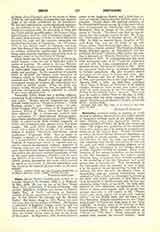

Bestiaries, medieval books on animals, in which the real or fabulous characteristics of actually existent or imaginary animals (such as the griffin, dragon, siren, unicorn, etc.) were figuratively treated as religious symbols of Christ, the devil, the virtues and vices. The origins of a symbolism of this character, taken from nature, are to be sought in antiquity and above all in the ancient East. Eastern literature, as well as the Greco-Roman literature dependent on it, ascribed to certain animals, whether fabulous or real (the lion, the tiger, the snake, the eagles), a certain connection with the life and actions of man and the gods, and made a corresponding religious use of them. This is exemplified in the Oriental and especially Egyptian worship of animals. Many reminiscences of this animal symbolism are encountered in the Old Testament. From the earliest period Christian fancy interpreted these animals according to the symbolism of the Old Testament, and so depicted them in Christian art. Thus, for example, in the Catacombs some are symbolic of what is good, e.g. the lamb or sheep representing the soul or the believer, the dove the soul, the phcenix Christ or immortality, and the peacock immortality; others symbolic of what is bad, e.g. the serpent representing the devil; still others, especially in later times, are to be interpreted in various senses; thus the lion may symbolize either Christ or the devil. An early compilation of such allegorical interpretations of the nature of plants and animals, made up partly from antique materials, is still extant in the “Physiologus“, the much copied and much used “natural history” of the Middle Ages, and the basis of all later bestiaries. Similar compilations are the “Liber formularum” of Eucherius, some parts of the “Libri originum” of Isidore, parts of the writings of Bede and Rabanus, and the treatise long ascribed to the second-century Melito of Sardes, and known as “Clavis” or “The Key”, which appeared in its present form towards the eleventh century. Later bestiaries obtained much valuable material from the “Libri moralium” of Gregory the Great. The medieval bestiaries are more or less exact translations or imitations of the “Physiologus“; e.g. the bestiary of Philippe de Thaun, about 1121, edited by Thomas Wright (London, 1841), and two bestiaries of the thirteenth century, one by Pierre of Picardy, the other by Guillaume of Normandy published by Hippeau (Caen, 1852). The bestiary appears in its complete development in Richard de Fournival’s “Bestiaire d’Amour”, written in the fourteenth century and published by Hippeau (Paris, 1860), in the treatise “De animalibus” attributed to BI. Albertus Magnus, in the “Tractatus de bestiis et aliis rebus” supposed to have been written by Hugo of St. Victor, above all in the “Speculum naturale” of Vincent of Beauvais.
The influence of the symbolism of the bestiaries is plainly seen in the various forms of medieval intellectual life. It was evident in the sermon and also in the liturgy as shown by the symbolic use of the bee in the blessing of Easter candles and the blessing of wine on the feast of St. John as a preventive of poisoning from snake-bites. The metrical animal fables, particularly, exhibit the widespread taste for this form of allegory. The influence of the symbolism of the bestiaries is still more manifest in medieval sculpture, both Romanesque and Gothic. Though the use of animal subjects in the oldest Irish and Merovingian art has apparently no deeper aim than the enjoyment of grotesque forms, yet animal symbolism appears from the earliest date as an element of Romanesque art, especially in miniature and sculpture, in both of which it often exhibits a close dependence on the bestiaries. (See Animals in Christian Art; Symbolism.)
JOSEPH SAUER

